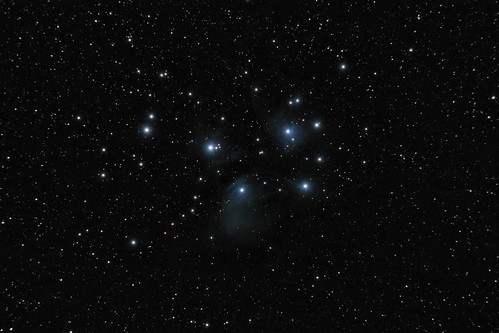21 January 2020, 18:45 – 20:15
Very cold, slight mist coming in off the sea (condensation started appearing on the scope within minutes of my carrying it outside).
Seeing: poor to average
Transparency: average to poor
Started with a tour of the Auriga Messier clusters at 50x (24mm Panoptic) followed by a look at the Pleiades in Taurus, comparing it with the image I took with the TV60 the previous Saturday night. The nebulosity around Merope and Maia was just about visible, but I think it would need one of those rare nights of exceptional transparency to see any structure to it.
I gave the Ethos a rest tonight (because of the condensation), so all subsequent observations at 133x (Nagler 9mm).
NGC 2281, open cluster, Auriga
Sparse collection of bright stars, four of them making a parallelogram at the western end of the cluster (the trailing two members of this shape are doubles). 133x is probably too high a magnification for this object; hard to tell where the cluster ended and the surrounding star-field began.
NGC 1931, “The Fly”, emission nebula / reflection nebula, Auriga
Little smear of light with 2 or 3 stars at centre. As noted before, quite bright for a non-Messier nebula. If the conditions were better I would have gone up to 240x. I also looked for neighbouring IC 417 (“The Spider”) and saw what appeared to be an extended patchy halo around a bright star, but difficult to say I saw it with any certainty.
NGC 1893, open cluster, Auriga
Sparse group of moderately bright stars. The area in and around the cluster seemed hazy, but not sure if that was because of unresolved stars or the surrounding nebulosity (IC 410). Might make an interesting imaging target if I get an appropriate filter.
Sigma Orionis, multiple star system
Impressive sight at 133x. Brightest component resolves into a wavy line of 4 stars. A pair of fainter doubles roughly northwest, and 2 even fainter stars between the two groups.
NGC 2261, Hubble’s Variable Nebula, Monoceros
Seemed more ghostly tonight (probably because of the transparency rather than the higher magnification). Averted vision showed a star-like point at the apex of the nebula. The “fan” of the nebula seemed brighter and fuller on the western side.
NGC 1535, planetary nebula, Eridanus
As per previous observation. The higher magnification showed a strong brightening towards the centre, but couldn’t isolate the central star with any confidence. Hint of brightness asymmetry with averted vision, but it came and went depending on which side of the nebula I was looking, so probably not a real feature. Colour less pronounced tonight – more grey than blue-grey.
NGC 1999, reflection nebula, Orion
As per previous observations. Relatively bright given the deteriorating transparency. Size increased with averted vision; star or star-like point at centre. Dark patch visible with averted vision, adjacent to the “star”.
From 20:15 onward the sky clouded over rather quickly, but the severe condensation had pretty much ended the session by that point anyway.
Nature note
Two frogs in the pond.


No comments:
Post a Comment